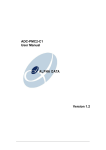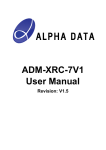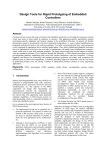Download XRM-FPDP Front Panel Data Port I/O Module User Manual
Transcript
XRM-FPDP Front Panel Data Port I/O Module User Manual Version 1.0 Alpha Data Copyright © 2008 Alpha Data Parallel Systems Ltd. All rights reserved. This publication is protected by Copyright Law, with all rights reserved. No part of this publication may be reproduced, in any shape or form, without prior written consent from Alpha Data Parallel Systems Limited Reserved rights This manual is designed to provide outline information only. Alpha Data has a continual policy of improving its products; hence it reserves the right to change product specification without prior warning. Alpha Data cannot accept any liability for loss or damages arising from the use of this manual or the use of products detailed within it. Warranty and Support All Alpha Data products enjoy parts and labor warranty for 12 months after purchase. The warranty is based on the customer returning the defective goods to Alpha Data for repair or replacement, which will be at the discretion of the company. The warranty does not cover damages caused by negligence, misuse, and normal wear and tear. No liability is accepted by the company for any damage caused by the use of its hardware or software. All goods from Alpha Data carry a 6 months free support service. This service is available by letter, phone, fax, and email. Technical support contracts for longer periods are available on request. Support contracts for software components also normally cover the cost of upgrades. Alpha Data 4 West Silvermills Lane Edinburgh EH3 5BD UK Alpha Data 2570 North First Street, Suite 440 San Jose, CA 95131 USA Phone: Fax: Email: Phone: (408) 467 5076 Fax: (866) 820 9956 Email: [email protected] +44 (0) 131 558 2600 +44 (0) 131 558 2700 [email protected] XRM-FPDP User Manual Version 1.0 Page 2 Alpha Data Table of Contents 1. Introduction............................................................................................... 4 1.1. Standards ............................................................................................. 4 2. Installation ................................................................................................ 4 2.1. Handling instructions ............................................................................ 4 2.2. Board Jumper Settings......................................................................... 4 3. Module Description................................................................................... 4 3.1. FPDP Interface..................................................................................... 4 3.2. J2 FPDP Pin Descriptions .................................................................... 5 3.3. FPDP Signal Descriptions .................................................................... 5 3.4. XRM Control signals............................................................................. 6 3.4.1. Control of FPDP Signal Termination ............................................... 6 3.4.2. Enabling FPDP Data / Control Busses............................................ 7 3.4.3. Control of PECL Strobe................................................................... 7 3.5. Encryption Battery ................................................................................ 7 XRM-FPDP User Manual Version 1.0 Page 3 Alpha Data 1. Introduction XRM I/O modules allow for re-configurable connectivity solutions using specific connectors and I/O standards. This modular approach allows for specific interfaces to be employed on common FPGA platforms. The XRM-FPDP is a front panel adapter module designed for use with Alpha Data’s FPGA based XRC boards. It can function as a receiver or transmitter of FPDP data. The Front Panel Data Port (FPDP) bus is intended to provide data transfer between two or more boards at up to 160MB/s with the lowest possible latency. The FPDP bus is a 32-bit parallel synchronous bus wired by means of an 80-conductor ribbon cable. 1.1. Standards ANSI/VITA 17-1998 (R2004) 2. Installation The XRM-FPDP is designed to plug into the front panel connector (SAMTEC QSH series) of an Alpha Data FPGA card. The retaining screws should be tightened to secure the XRM-FPDP. Note: This operation should not be performed while the host PMC or PCI card is powered up. 2.1. Handling instructions Observe ESD precautions when handling the modules to prevent damage to components by electrostatic discharge. Avoid flexing the board. 2.2. Board Jumper Settings The XRM-FPDP uses a 3.3V signalling voltage with the FPGA board. The proper setting must be made on the XRC host board for the front I/O voltage; typically done via a switch or jumper on the XRC board. 3. Module Description The XRM-FPDP IO module provides connection to Front Panel Data Port interfaces. It uses the standard 80 way KEL 8831E-080-170L or RN P50E-080P1-SR1-TG connector with Non Inverted FPDP pin assignments described in VITA17. 3.1. FPDP Interface The XRM-FPDP utilizes bi-directional bus switches for all electrical connections to the J2 FPDP connector. This provides 5V signalling level tolerance and translates the signalling voltage to 3.3V for the FPGA connections. XRM-FPDP User Manual Version 1.0 Page 4 Alpha Data 3.2. J2 FPDP Pin Descriptions FPDP Pin 1 3 5 7 9 11 13 15 17 19 21 23 25 Function 27 GND GND GND Nrdy Dir Reserved Suspend GND PIO2 PIO1 Reserved Resreved Pstrobe +ve Pstrobe -ve 29 31 33 35 37 39 41 43 45 47 49 51 53 55 57 59 61 63 65 67 69 71 73 75 77 79 Sync Dvalid D31 GND D28 D27 GND D24 D23 GND D20 D19 GND D16 D15 GND D12 D11 GND D08 D07 GND D04 D03 GND D00 J1 Samtec Pin 77 73 74 63 64 89 (in) or 91(out) 89 (in) or 91(out) 61 62 37 34 33 30 29 26 25 22 21 18 17 14 13 10 9 6 XRM Bus Name IO_50P_1 IO_72N_1 IO_71P_1 IO_73P_1 IO_68P_1 * FPDP Pin 2 4 6 8 10 12 14 16 18 20 22 24 26 Function Strob GND GND GND GND GND GND GND GND GND GND GND GND J1 Samtec Pin 38 - XRM Bus Name CLK0 - * 28 GND - - IO_73N_1 IO_68N_1 IO_51P_1 IO_26N_1 IO_49N_1 IO_20P_1 IO_22N_1 IO_29P_1 IO_28N_1 IO_2N_1 IO_25N_1 IO_23P_1 IO_3P_1 IO_54N_1 IO_5N_1 IO_52N_1 IO_6N_1 IO_30P_1 30 32 34 36 38 40 42 44 46 48 50 52 54 56 58 60 62 64 66 68 70 72 74 76 78 80 GND GND D30 D29 GND D26 D25 GND D22 D21 GND D18 D17 GND D14 D13 GND D10 D09 GND D06 D05 GND D02 D01 GND 36 35 32 31 28 27 24 23 20 19 16 15 12 11 8 7 - IO_26P_1 IO_49P_1 IO_20N_1 IO_22P_1 IO_29N_1 IO_28P_1 IO_2P_1 IO_25P_1 IO_23N_1 IO_3N_1 IO_54P_1 IO_5P_1 IO_52P_1 IO_6P_1 IO_30N_1 IO_19P_1 - * Note: the Pstrobe +/- differential PECL signal connects to a driver/receiver on the XRM module. This is connected to the Samtec connector on pin 89 as a clock input to the FPGA or on pin 91 as a clock output from the FPGA. (see control signals in section 3.4.3) 3.3. FPDP Signal Descriptions SIGNAL D<31:00> DIR* DVALID* NAME Data Bus Data Direction Data Valid STROB Data Strobe NRDY* Not Ready COMMENTS 32-bit data bus driven by FPDP/TM Interfaces. The FPDP/TM asserts DIR* low. When asserted, DVALID* indicates that the data bus has valid data. This signal is generated by the FPDP/TM. STROB is a free running clock supplied by the FPDP/TM. FPDP/R and FPDP/RM interfaces should sample the data with the rising edge of STROB when DVALID* is asserted. NRDY* should be asserted by FPDP/R or FPDP/RM interfaces, when they are not ready to receive data. The XRM-FPDP User Manual Version 1.0 Page 5 Alpha Data PIO1, PIO2 Programmable I/O PSTROBE +PECL Data Strobe PSTROBE* -PECL Data Strobe Reserved SUSPEND* Suspend Data SYNC* Sync Pulse FPDP/TM should sample this signal until the FPDP/R or FPDP/RM brings it high, at which time the transfer should commence. Since NRDY* is asynchronous to STROB, the FPDP/TM should double-synchronize to it before sampling its state; this avoids metastability problems. The PIO signals are programmable I/O lines. They may be configured as inputs or outputs. This signal along with PSTROBE* may be generated by the FPDP/TM as an optional differential ±PECL data strobe. PSTROBE is the positive version of the differential clock and has the same polarity as STROB. For high data rate applications, the differential ±PECL data strobe should be used instead of STROB. This signal is the negative version of the differential PECL data strobe. No connection should be made to reserved signals. SUSPEND* should be generated by FPDP/R or FPDP/RM interfaces to inform the data source of a pending buffer overflow condition. The FPDP/TM may delay for no more than 16 cycles in total before suspending the transfer by negating DVALID*. Since SUSPEND* is asynchronous to STROB, the FPDP/TM should double-synchronize to it before sampling its state; this avoids metastability problems. The FPDP/TM must provide a Sync pulse to FPDP/R and FPDP/RM interfaces to synchronize data transfers when transmitting Single Frame data, Fixed Size Repeating Frame data or Dynamic Size Repeating Frame data. FPDP/R and FPDP/RM interfaces should wait for the Sync pulse before accepting data. FPDP/R and FPDP/RM interfaces should start to accept data on the first Data Valid period following the Sync pulse. 3.4. XRM Control signals There are 6 signals provided from the FPGA to the XRM-FPDP to control the operation of the interface. This allows the module to be configured as a transmitter or receiver. The control signal allocations from the FPGA are shown below: Signal Control<0> 0:- Enable FPDP Control line termination 1:- Disable FPDP Control line termination Pull-Up 0 0 J1 Samtec Pin 67 Control<1> 0 :- Receiver terminations 1:- Transmitter termination 0 :- enable FPDP Control lines 1 :- Isolate FPDP Control lines 0 :- enable FPDP Data lines 1 :- Isolate FPDP Datal lines 0 :- enable FPDP PECL strobe 1 :- Disable FPDP PECL strobe 0 :- enable receive FPDP PECL strobe 1 :- enable transmit FPDP PECL strobe Pull-Up 1 0 68 IO_76P_1 Pull-Up 0 0 65 IO_67N_1 Pull-Up 0 0 66 IO_76N_1 Pull-Up 0 0 69 IO_70N_1 Pull-Up 1 0 70 IO_53N_1 Control<2> Control<3> Control<4> Control<5> Description H/W Default TX Operation RX Operation XRM Bus Name IO_67P_1 3.4.1. Control of FPDP Signal Termination Control<1> selects the group of signals for termination depending on if the XRM-FPDP is the transmitter or receiver. When it is the receiver, the signals Dir and Strob are inputs and should be terminated. When it is the transmitter, the signals Nrdy and Suspend are inputs and should be terminated. Control<0> XRM-FPDP User Manual Version 1.0 Page 6 Alpha Data enables the termination of the selected group, and connects each signal to a 220 ohm pull-up and 330 ohm pull-down per the VITA17 specification. 3.4.2. Enabling FPDP Data / Control Busses Control<2> and Control<3> enable the FPDP control lines and data lines respectively. When disabled, the corresponding FPDP signals are isolated from the J2 connector. 3.4.3. Control of PECL Strobe The XRM-FPDP has a differential PECL driver/receiver to provide the FPDP Pstrobe signals for higher data rate applications. This differential strobe connection is enabled by control<4>. When control<5> is ‘1’ The PECL driver is sourced from a single-ended FPGA signal, and driven as differential PECL to the FPDP connector. When control<5> is ‘0’ the differential PECL receiver converts the FPDP inputs to a singled ended signal to the FPGA clock input. When the Pstrobe receive option is selected, the appropriate termination is provided by the XRM module. 3.5. Encryption Battery The XRM-FPDP provides a battery as a backup power source for the XRC FPGA board encryption key. This is connected to VBATT of the target FPGA via the J1 Samtec connector. For more information see the relevant Xilinx user guide on using encrypted bitstreams. XRM-FPDP User Manual Version 1.0 Page 7




















